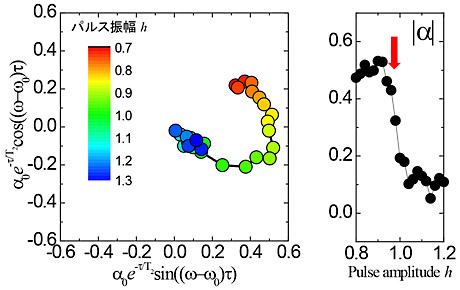Quantum State Projection with Various Measurement Strengths
Kosuke Kakuyanagi, Hayato Nakano, Kouichi Semba*, and Shiro Saito
Physical Science Laboratory, *NII
A superconducting loop, which has Josephson junctions, exhibits discrete energy levels. In particular, in an external magnetic field of around Φ = 0.5Φ0, we can ignore the higher energy levels of this superconducting circuit, and so the circuit works as a two-level quantum system called a superconducting flux qubit. These quantum systems can represent both an excited state and a ground state, which correspond to "1" and "0", respectively, and the superposition of two states. When we measure a quantum superposition state, the quantum state is probabilistically projected to an excited state or a ground state. By using a superconducting qubit, we can generate a superposition state and measure a quantum state on the superconducting circuit.
We measure a superconducting flux qubit state using the Josephson bifurcation readout method, which employs the bistable state of a non-linear resonator. With this readout method, we can detect convergent states of a nonlinear resonator that depend on the qubit state by achieving coupling between a superconducting qubit and a non-linear resonator. This readout method has advantages including a fast and low measurement back-action. To understand how the projection occurs, we performed an experiment in which we undertook a readout strength dependent measurement [1].
First, we generate an arbitrary superposition state by operating a rotation gate. Next, we apply various amplitude readout pulses to the qubit. At that time, if state projection occurs, a mixed state consisting of an excited state and a ground state appears. On the other hand, if projection does not occur, the quantum state maintains a pure state. To distinguish between these two states, we measure the final state of the qubit after employing a rotation operation. The experiment was performed at a few 10 mK to avoid the effect of thermal excitation. Figure 1 shows the readout pulse amplitude dependence of the dephasing indicator α using the usual readout pulse amplitude as a standard. When the pulse amplitude reaches h = 0.9, the α value suddenly decreases. This result means the projection suddenly occurs when we increase the measurement strength. This experimental result supports a theoretical analysis of the Josephson bifurcation readout method [2].
- [1]
- K. Kakuyanagi, S. Kagei, R. Koibuchi, S. Saito, A Lupaşcu, K. Semba, and H. Nakano, New J. Phys. 15 (2013) 043028.
- [2]
- H. Nakano, S. Saito, K. Semba, and H. Takayanagi, Phys. Rev. Lett. 102 (2009) 257003.

|
- Fig. 1.
- Measurement strength dependence of α.
|
|
<< Prev | Contents | Next >>
